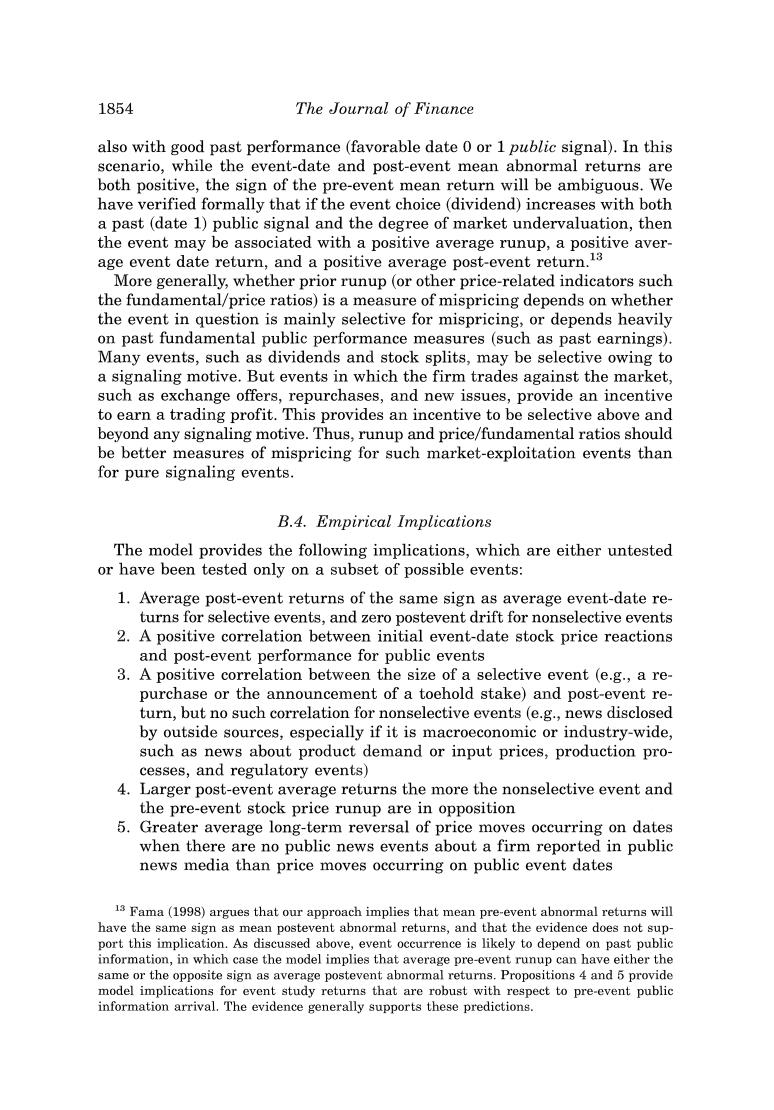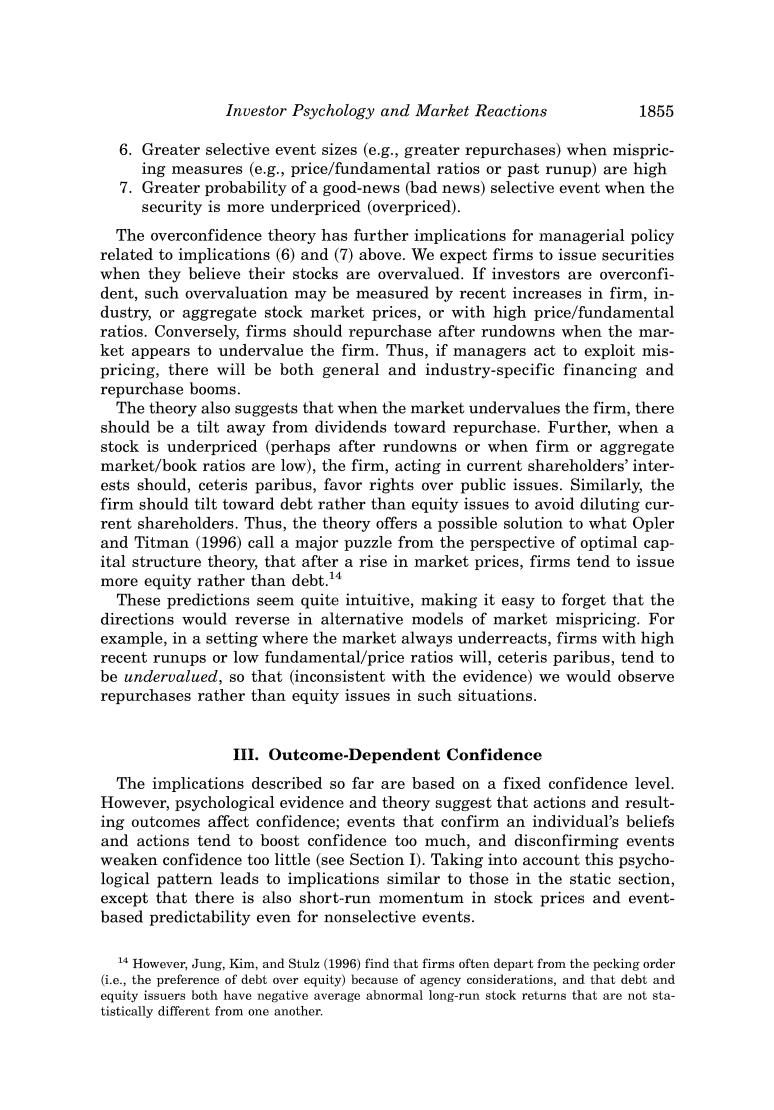
1854 The Journal of Finance also with good past performance(favorable date 0 or 1 public signal).In this scenario,while the event-date and post-event mean abnormal returns are both positive,the sign of the pre-event mean return will be ambiguous.We have verified formally that if the event choice(dividend)increases with both a past (date 1)public signal and the degree of market undervaluation,then the event may be associated with a positive average runup,a positive aver- age event date return,and a positive average post-event return.13 More generally,whether prior runup (or other price-related indicators such the fundamental/price ratios)is a measure of mispricing depends on whether the event in question is mainly selective for mispricing,or depends heavily on past fundamental public performance measures(such as past earnings). Many events,such as dividends and stock splits,may be selective owing to a signaling motive.But events in which the firm trades against the market, such as exchange offers,repurchases,and new issues,provide an incentive to earn a trading profit.This provides an incentive to be selective above and beyond any signaling motive.Thus,runup and price/fundamental ratios should be better measures of mispricing for such market-exploitation events than for pure signaling events. B.4.Empirical Implications The model provides the following implications,which are either untested or have been tested only on a subset of possible events: 1.Average post-event returns of the same sign as average event-date re- turns for selective events,and zero postevent drift for nonselective events 2.A positive correlation between initial event-date stock price reactions and post-event performance for public events 3.A positive correlation between the size of a selective event (e.g.,a re- purchase or the announcement of a toehold stake)and post-event re- turn,but no such correlation for nonselective events(e.g.,news disclosed by outside sources,especially if it is macroeconomic or industry-wide, such as news about product demand or input prices,production pro- cesses,and regulatory events) 4.Larger post-event average returns the more the nonselective event and the pre-event stock price runup are in opposition 5.Greater average long-term reversal of price moves occurring on dates when there are no public news events about a firm reported in public news media than price moves occurring on public event dates 13 Fama(1998)argues that our approach implies that mean pre-event abnormal returns will have the same sign as mean postevent abnormal returns,and that the evidence does not sup- port this implication.As discussed above,event occurrence is likely to depend on past public information,in which case the model implies that average pre-event runup can have either the same or the opposite sign as average postevent abnormal returns.Propositions 4 and 5 provide model implications for event study returns that are robust with respect to pre-event public information arrival.The evidence generally supports these predictions

Investor Psychology and Market Reactions 1855 6.Greater selective event sizes (e.g.,greater repurchases)when mispric- ing measures (e.g.,price/fundamental ratios or past runup)are high 7.Greater probability of a good-news (bad news)selective event when the security is more underpriced (overpriced). The overconfidence theory has further implications for managerial policy related to implications(6)and(7)above.We expect firms to issue securities when they believe their stocks are overvalued.If investors are overconfi- dent,such overvaluation may be measured by recent increases in firm,in- dustry,or aggregate stock market prices,or with high price/fundamental ratios.Conversely,firms should repurchase after rundowns when the mar- ket appears to undervalue the firm.Thus,if managers act to exploit mis- pricing,there will be both general and industry-specific financing and repurchase booms. The theory also suggests that when the market undervalues the firm,there should be a tilt away from dividends toward repurchase.Further,when a stock is underpriced (perhaps after rundowns or when firm or aggregate market/book ratios are low),the firm,acting in current shareholders'inter- ests should,ceteris paribus,favor rights over public issues.Similarly,the firm should tilt toward debt rather than equity issues to avoid diluting cur- rent shareholders.Thus,the theory offers a possible solution to what Opler and Titman(1996)call a major puzzle from the perspective of optimal cap- ital structure theory,that after a rise in market prices,firms tend to issue more equity rather than debt.14 These predictions seem quite intuitive,making it easy to forget that the directions would reverse in alternative models of market mispricing.For example,in a setting where the market always underreacts,firms with high recent runups or low fundamental/price ratios will,ceteris paribus,tend to be undervalued,so that (inconsistent with the evidence)we would observe repurchases rather than equity issues in such situations. III.Outcome-Dependent Confidence The implications described so far are based on a fixed confidence level. However,psychological evidence and theory suggest that actions and result- ing outcomes affect confidence;events that confirm an individual's beliefs and actions tend to boost confidence too much,and disconfirming events weaken confidence too little(see Section I).Taking into account this psycho- logical pattern leads to implications similar to those in the static section, except that there is also short-run momentum in stock prices and event- based predictability even for nonselective events. 14However,Jung,Kim,and Stulz(1996)find that firms often depart from the pecking order (i.e.,the preference of debt over equity)because of agency considerations,and that debt and equity issuers both have negative average abnormal long-run stock returns that are not sta- tistically different from one another